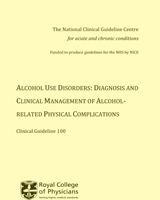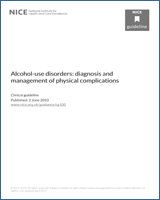Apart from any fair dealing for the purposes of research or private study, criticism or review, as permitted under the Copyright, Designs and Patents Act, 1988, no part of this publication may be reproduced, stored or transmitted in any form or by any means, without the prior written permission of the publisher or, in the case of reprographic reproduction, in accordance with the terms of licences issued by the Copyright Licensing Agency in the UK. Enquiries concerning reproduction outside the terms stated here should be sent to the publisher at the UK address printed on this page.
NCBI Bookshelf. A service of the National Library of Medicine, National Institutes of Health.
National Clinical Guideline Centre (UK). Alcohol Use Disorders: Diagnosis and Clinical Management of Alcohol-Related Physical Complications [Internet]. London: Royal College of Physicians (UK); 2010. (NICE Clinical Guidelines, No. 100.)
August 2019: Some glossary terms were updated by NICE, and the recommended alcohol units for men and women were updated in line with advice from the UK Chief Medical Officer.

Alcohol Use Disorders: Diagnosis and Clinical Management of Alcohol-Related Physical Complications [Internet].
Show detailsAlcohol is the most widely used psychotropic drug in the industrialised world; it has been used for thousands of years as a social lubricant and anxiolytic. In the UK, it is estimated that 24% of adult men and 13% of adult women drink in a hazardous or harmful way3. Levels of hazardous and harmful drinking are lowest in the central and eastern regions of England (21–24% of men and 10–14% of women). They are highest in the north (26–28% of men, 16–18% of women)3. Hazardous and harmful drinking are commonly encountered amongst hospital attendees; 12% of emergency department attendances are directly related to alcohol4 whilst 20% of patients admitted to hospital for illnesses unrelated to alcohol are drinking at potentially hazardous levels5. Continued hazardous and harmful drinking can result in dependence and tolerance with the consequence that an abrupt reduction in intake might result in development of a withdrawal syndrome. In addition, persistent drinking at hazardous and harmful levels can also result in damage to almost every organ or system of the body. Alcohol-attributable conditions include liver damage, pancreatitis and the Wernicke’s encephalopathy. Key areas in the investigation and management of these conditions are covered in this guideline.
Many other and diverse conditions are associated with chronic alcohol misuse, which will not be covered in the guideline. There are examples listed in Table 1-1 below. As well as these physical problems there are the social consequences of harmful and hazardous drinking. These vary according to age group, but can be devastating. Antisocial behaiour and teenage pregnancy in the young, domestic violence and employment issues in the middle aged and social isolation in the elderly. Again, these are not covered in this particular guideline.
Table 1-1
Conditions associated with chronic alcohol misuse.
During the writing of the guideline, the GDG has given consideration to the management of patients according to their gender, age and ethnic origin. Where evidence is age-specific, this is reflected in the recommendations. Among ethnic groups there is variability in the dose and pattern of alcohol consumption 6 and possibly also in the susceptibility to develop alcohol-related cirrhosis7. This evidence may have an impact on the recommended sensible limits of alcohol consumption (see public health guideline) for specific ethnic groups. In general, however, regardless of susceptibility, the management of the alcohol use disorder is largely the same across ethnic groups. Where the evidence suggests otherwise, this has been reflected in the recommendation.
- Addendum to NICE guideline 100, Alcohol-use disorders: diagnosis and management of physical complications
- Alcohol-use disorders: physical complications: Evidence Update March 2012: A summary of selected new evidence relevant to NICE clinical guideline 100 'Diagnosis and management of alcohol-related physical complications' (2010)
- Surveillance report 2016 - Alcohol-use disorders: diagnosis and management of physical complications (2010) NICE guideline CG100
- 2019 surveillance of alcohol-use disorders: diagnosis and management of physical complications (NICE guideline CG100)
- Background - Alcohol Use DisordersBackground - Alcohol Use Disorders
Your browsing activity is empty.
Activity recording is turned off.
See more...
